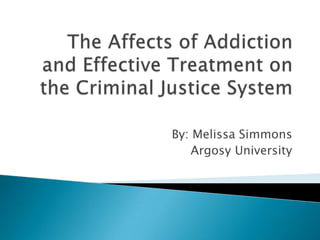
The Affects Of Addiction And Effective Treatment On
- 1. The Affects of Addiction and Effective Treatment on the Criminal Justice System By: Melissa Simmons Argosy University
- 2. The criminal justice system consists of the police, judicial system and correctional system. If a person commits a crime then they are arrested by the police, go to court for trial and sentenced to a jail, prison or probation/parole. Many people face a disease called addiction. Their addiction can consist of alcohol, drugs, sex and or gambling. The addiction that affects the criminal justice system the most is drug addiction. The government spends billions of dollars every year incarcerating victims of addiction instead of treating them properly with evidence based treatments. Addiction affects the police, the judicial system and the correctional system by increased crime, overcrowding in the jails and prisons and increased recidivism.
- 3. Affects on The Police Crimes occur because a person needs money to buy drugs. In 2006, 1.9 million people were arrested for drug offenses and 82.5% were for possession (Cutler, 2009).
- 4. Affects on the Police Addiction creates increased crime and impacts the police community in a negative way. Addiction is hard to diagnose but it becomes apparent when a person is committing crimes in order to obtain their drug of choice
- 5. After a person commits a crime and is charged by the police, they are sent to court. Making the decision of charging a person with a crime is a challenge as drugs and alcohol affect a person’s thinking abilities and judgment (Elizabeth Henderson, 2000). Affects on the Judicial System
- 6. In 2006, sixty-three percent of property and drug offenders were dependant on or abusing drugs at the time of their offense (Cutler, 2009) The judge is the determining factor if the person has to go to jail or prison and not receive proper treatment or be released to a treatment center. Affects on the Judicial System
- 7. The affects of President Regan’s “War on Drugs” has had an opposite affect on the correctional system. The crime has increased, the prisons are overcrowded, the government spends more money and inmates are frustrated with their unjust sentences (Cutler, 2009). In 1990, the government spent 769.2 million dollars on incarceration (Cutler, 2009). Affects on the Correctional System
- 8. Affects on Correctional System In 2002, 68% of inmates had a substance abuse or dependence issue prior to incarceration. Of those incarcerated, 13% to 32% reported receiving addiction treatment in prison. Due to this, many people leave prison without ever receiving treatment and relapse soon after being released. (Friedmann, 2008)
- 9. Affects on Correctional System Offenders are released on parole. 24% of them return to prison within three years due to violations of their parole (Friedmann,2008). Some of these violations include; failure to attend drug treatment, detected substance abuse and re-arrest for another crime (Friedmann, 2008). Many of these crimes are committed in order to make money to seek their drug of choice.
- 10. There are many types of treatment for addiction. AA, NA and drug court are step programs but are not evidence based and do not address criminal behaviors and how they are connected to addiction. Effective Treatment
- 11. Collaborative behavior management. This treatment uses operant conditioning that states behavior followed by reinforcement will be repeated, whereas behavior followed by punishment will decrease or discontinue (Friedmann, 2008.) Focuses on treatment adherence and reduced recidivism. Effective Treatment
- 12. Cognitive behavioral therapy focuses on the offender’s thinking and its impact on their perceptions of themselves and their environment. Focus is on “thinking errors” offenders use to justify their criminal behavior, like denial. (Simpson, 2008). Therapeutic community treatment teaches that substance abuse is not the cause of the criminal behavior, but it is one symptom of the whole person. It teaches the offender about pro social behavior and how to rely on peer support. Emphasizes the importance of accountability and responsibility (Simpson, 2008). Effective Treatment
- 13. Addiction is a disease that affects the entire criminal justice system; police, judicial system and correctional system. With increased crime, overcrowding in prisons and increased recidivism the answer is not to incarcerate more people who suffer from addiction. This only worsens the problem. Effective treatment is available and each offender with an addiction should have the opportunity to help themselves. If a person receives treatment then the likelihood of them committing another crime and going back to prison is reduced significantly. Offering evidence based treatment will help reduce cost for incarceration, lower crime rates and help people learn to live healthier, crime free lives. Conclusion
- 14. Cutler, L. (2009). Arizona's Drug Sentencing Statute: Is Rehabilitation a Better Approach to the War on Drugs? New England Journal on Criminal and Civil Confinement , 397-419. Elizabeth Henderson, M. (2000). Understanding Addiction. Jackson: University Press of Mississippi. Friedmann, P. D. (2008). Collaborative Behavioral Management for Drug-Involved Parolees: Rationale and Design of the Stepn'n Out Study. Journal of Offender Rehabilitation , 290-318. Randall G. Shelden, W. B. (2003). Criminal Justice in America: A Critical View. Boston: Allyn and Bacon. Simpson, M. T. (2008). Identifying the Proper Drug-Abuse Treatment for Offenders. Corrections Today , 70-72. Torr, J. D. (2004). Crime and Criminals. San Diego: Greenhaven Press. References